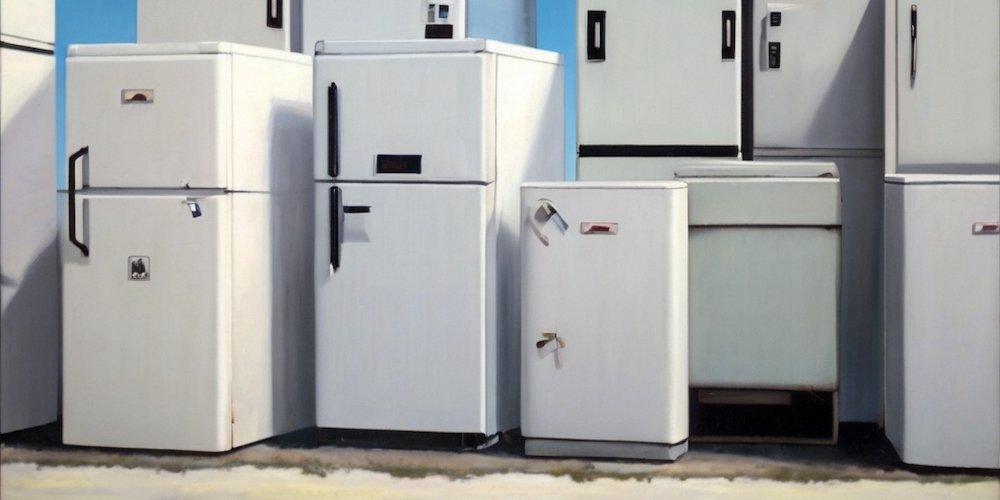Proper refrigerator disposal is crucial for environmental and safety reasons. Old refrigerators contain harmful chemicals like Freon, which can damage the ozone layer if not handled correctly. Many local waste management services offer special pick-up days for large appliances. Professional recycling services can also ensure that your refrigerator is disposed of in an eco-friendly manner.
Always check local regulations, as some areas may require specific steps or certifications for appliance disposal. Safely removing a refrigerator from your home ensures that you comply with environmental laws and contribute to a healthier planet.
Research Local Regulations
Dispose of a refrigerator involves more than just taking it to the curb. Improper disposal can harm the environment and even be illegal. Researching local regulations is essential to ensure that you follow the correct procedures. This blog post will guide you through the steps you need to take.
Check With Local Waste Management
Local waste management authorities often have specific rules for disposing of large appliances like refrigerators. These rules ensure that harmful substances, such as refrigerants, are properly handled.
Here are some steps to follow:
- Contact your local waste management office to ask about their refrigerator disposal policies.
- Inquire about any fees associated with the disposal process.
- Ask if they offer curbside pickup or if you need to drop off the appliance at a designated location.
- Find out if you need to remove the doors or any other parts before disposal.
Some localities may offer special collection days for large items. Others might require you to schedule a pickup in advance. Knowing the rules ahead of time will save you from fines and ensure that you are disposing of your refrigerator responsibly.
Research Recycling Centers
Recycling centers are another option for disposing of your old refrigerator. These centers often have the facilities to break down the appliance and recycle its parts.
Here are some tips for finding a suitable recycling center:
- Search online for recycling centers in your area that accept refrigerators.
- Contact the centers to ask about their procedures and any associated costs.
- Check if they offer pickup services or if you need to transport the appliance yourself.
- Ask about any preparation steps, such as removing the doors or draining refrigerants.
Some recycling centers might even offer incentives, such as cash for your old appliance. Recycling your refrigerator not only helps the environment but also ensures that valuable materials are reused. This is a win-win situation for everyone involved.
Prepare The Refrigerator
Dispose of a refrigerator can be a daunting task. It’s essential to follow the right steps to ensure safety and compliance with local regulations. Proper preparation of the refrigerator is crucial before disposal. This blog post will guide you through the necessary steps to prepare your refrigerator for disposal.
Empty The Contents
First, remove all items from the refrigerator. This includes food, drinks, and any storage containers. Check expiration dates and throw away anything spoiled. Transfer perishables to a cooler or another refrigerator to keep them fresh.
Here are some steps to make the process easier:
- Organize items into categories: perishable, non-perishable, and expired.
- Dispose of expired items responsibly. Use compost bins if possible.
- Clean storage containers and keep them for future use.
Once the refrigerator is empty, remove all shelves and drawers. Clean these parts with warm, soapy water. This prevents mold and odors during the disposal process.
Unplug the refrigerator to ensure it is not using any power. This step is crucial for safety and energy conservation.
Defrost The Freezer
Defrosting the freezer is an important step. Ice buildup can make the refrigerator heavy and difficult to move. Turn off the freezer and leave the door open to allow the ice to melt.
Here are some tips to defrost the freezer efficiently:
- Place towels around the base to absorb water.
- Use a fan to speed up the melting process.
- Avoid using sharp objects to remove ice to prevent damage.
Once the ice has melted, wipe down the interior of the freezer. Remove any remaining moisture with a dry cloth. This prevents mold growth and keeps the unit clean for disposal.
Ensure the refrigerator is completely dry before moving it. This makes the disposal process safer and more efficient.
Disassemble The Refrigerator
Dispose of a refrigerator can be tricky. You must follow the correct steps. First, disassemble the refrigerator. This ensures it is safe and manageable. In this guide, learn how to remove parts and dispose of them properly.
Remove Doors And Shelves
First, unplug the refrigerator. Make sure it is not connected to electricity. Next, open the doors wide. This helps you access the shelves easily. Use a screwdriver to remove the screws from the door hinges. Carefully take the doors off and set them aside.
Once the doors are off, focus on the shelves. Most shelves can be lifted out. Some might have clips or screws. Check for these and remove them if needed. Remember to handle glass shelves with care. They can break easily.
Label the parts if you plan to recycle. This helps in identifying what goes where. Gather all small parts like screws in a bag. This prevents losing them. Now, the refrigerator is ready for the next step.
Detach The Compressor
The compressor is an important part of the refrigerator. Locate the compressor at the back or bottom. Use a wrench to loosen the bolts holding it. Carefully pull out the compressor from its place. Be cautious, as it might have leftover refrigerant.
Some compressors might have wires connected. Use wire cutters to snip the wires. Label the wires if necessary. This makes recycling easier. Place the compressor in a safe area. It contains chemicals that need proper disposal.
Check local recycling centers for compressor disposal. Many places have special rules for these parts. Follow them to ensure safe disposal. Never throw the compressor in regular trash. It can harm the environment.
Choose A Disposal Method
Dispose of a refrigerator is not just about getting rid of an old appliance. It involves taking steps to ensure the process is environmentally friendly and safe. Choosing the right disposal method is crucial. You can recycle the refrigerator or donate the appliance. Each method has its benefits and requirements. Let’s explore how to do it properly.
Recycle The Refrigerator
Recycling an old refrigerator helps protect the environment. This process ensures that harmful materials do not end up in landfills. Many parts of a refrigerator can be recycled, such as metals, plastics, and glass.
Here are steps to recycle your refrigerator:
- Contact your local recycling center: Many centers offer refrigerator recycling services.
- Schedule a pickup: Some centers will pick up the appliance from your home.
- Prepare the refrigerator: Remove all food and clean the interior.
- Follow safety guidelines: Ensure the refrigerator is unplugged and the doors are secured.
Recycling centers safely dispose of refrigerants and other harmful chemicals. They also ensure that valuable materials are recovered and reused. This reduces the need for new raw materials. It also helps in minimizing environmental pollution. Always check with local authorities for specific recycling guidelines in your area.
Donate The Appliance
If your refrigerator is still in working condition, consider donating it. Donating helps others in need and reduces waste. Many organizations accept used appliances.
Here are steps to donate your refrigerator:
- Find a charity or organization: Look for local charities that accept appliance donations.
- Contact the organization: Reach out to confirm they can take your refrigerator.
- Schedule a drop-off or pickup: Some charities offer free pickup services.
- Prepare the appliance: Clean the refrigerator and ensure it is in good working order.
Donating your refrigerator can make a significant difference for families in need. It is a simple way to contribute to your community. Make sure to get a receipt for your donation. This may provide you with a tax benefit. Check with the organization for any specific requirements or restrictions. Donating helps extend the life of the appliance and supports sustainability efforts.
Properly Dispose Of Hazardous Materials
Dispose of a refrigerator requires special care, because it contains hazardous materials. Proper disposal is essential for environmental safety. This guide will help you understand the steps needed to dispose of a refrigerator responsibly.
Remove and Recycle Refrigerant
Refrigerators contain refrigerants that are harmful to the environment. It is important to remove these safely. You need to contact a professional to do this job. Never attempt to remove refrigerant yourself. Professionals have the tools to do it safely.
Here are some steps professionals follow:
- Identify the type of refrigerant used in the refrigerator.
- Use special equipment to extract the refrigerant.
- Store the refrigerant in a secure container.
- Transport it to a recycling facility for proper disposal.
By following these steps, professionals ensure the refrigerant does not harm the environment. Recycling refrigerant is crucial for reducing pollution and protecting the ozone layer. Make sure to hire a certified technician for this job.
Safely Dispose Of Refrigerator Insulation
Refrigerator insulation can contain harmful chemicals. Proper disposal of insulation is important for health and safety. You should not handle insulation without protective gear.
Here are the steps to safely dispose of refrigerator insulation:
- Wear protective gloves and masks to avoid direct contact.
- Carefully remove the insulation from the refrigerator.
- Place the insulation in a sealed bag to prevent contamination.
- Transport the sealed bag to a hazardous waste disposal facility.
Disposing of insulation properly prevents harmful chemicals from polluting the environment. Always ensure the insulation is handled with care. Using a licensed waste disposal service is highly recommended for this process.
Proper disposal of refrigerator insulation keeps you and the environment safe. Do not ignore this step when disposing of your old refrigerator.
Frequently Asked Questions
What Do You Do With An Old Refrigerator?
Recycle it at a local recycling center. Donate it to charity if it’s still working. Sell it online for extra cash.
How Do I Get Rid Of An Old Refrigerator For Free Near Me?
Contact local recycling centers or waste management services. Check for bulk trash pickup days. Donate to charities or use online marketplaces like Craigslist or Freecycle. Some appliance stores offer free removal with new purchases.
How Do I Dispose Of A Large Fridge?
Contact your local waste management service for large appliance pick-up. Consider donating if the fridge works. Use certified recycling centers. Check retailers for haul-away programs when buying a new fridge. Ensure proper disposal to avoid environmental harm.
Conclusion
Disposing of a refrigerator responsibly is crucial for the environment. Follow local regulations and consider recycling options. Always prioritize eco-friendly methods. This ensures safe removal and benefits future generations. Proper disposal protects the planet and conserves resources. Make a positive impact by disposing of your refrigerator correctly.







